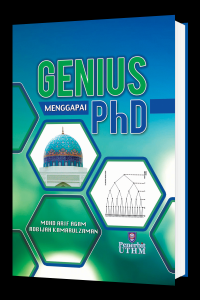GENIUS MENGGAPAI PhD
Keywords:
Teori Chaos, PhD, kreativiti, kejayaan, ilmuSynopsis
Buku ini mengupas persoalan bagaimana keilmuan diterokai, yang sebenarnya berbentuk rawak atau “chaos”. Memahami Teori Chaos, mampu memberikan kita kesedaran bahawa setiap elemen terkecil jika dibiarkan berlarutan atau dilaksanakan secara berterusan, bakal memberikan ledakan situasi dan peluang. Kejayaan menggapai PhD, adalah bermula dengan kefahaman sikap menghargai elemen usaha terkecil yang bakal membawa kita kepada kejayaan memperolehi PhD, atau apa juga kejayaan yang ingin kita lakarkan. Kreativiti melakukan projek kecil seperti pengumpulan artikel, penulisan definasi dan penerangan istilah kedalam fail indeks, adalah langkah-langkah kreativiti kecil yang sebenarnya berperanan menghasilkan ledakan kejayaan. Buku ini mengupas persoalan Teori Chaos dan bagaiamana ianya berfungsi dalam melakarkan kejayaan menggapai PhD. Buku ini sebenarnya boleh digunakan oleh pelbagai lapisan masyarakat dalam memahami bagaimana sesuatu kejayaan penerokaan ilmu dapat dimulakan hanya dengan memulakan suatu langkah yang tergambarkan sebagai suatu titik.
Downloads
References
A.L Porter, J. Youtie (2009).Where does Nanotechnology Belong in the Map of Science?. Nature Nanotechnology (4)534.
A.Yahaya, S.Ahmad, Y. Boon (2008). Psikologi Pendidikan. UTM Al-Quran
Albert Einstein (1954). Ideas and Opinions.Crown Publisher.New York.
Dunn, R., & Dunn, K.(1992).Teaching secondary students through their individual learning styles.Boston: Allyn & Bacon.
Enabling Science and Nanotechnology (2010). International Conference On Enabling Science And Nanotechnology Escinano; doi:10.1063/1.3586954
Falsafah Pendidikan Negara (1988). Pusat Perkembangan Kurikulum, Kementerian Pendidikan
Farizan Mohamad (2011). UV Spectra of Protein Immobilized at Nanopillars Formation through Nanosphere Lithography (NSL) Plasma Treatment. AIP Conf. Proc.pp.54-61
G. Halevi, Dr. Henk.(2012), The Evolution of Big Data as a Research and Scientific Topic, Research Trend, 30(3).
Gordon Rugg, Marian Petre (2004). The Unwritten Rules of PhD Research.Open University Press.
H. Gardner (1983). Frames of Mind: The Theory of Multiple Intelligences. Basic Books.
Howard, J.(2002).Technology-enhanced project-based learning in teacher education: Addressing the goals of transfer. Journal of Technology and Teacher Education, 10(3), 343- 364.
http://en.wikipedia.org/wiki/Albert_Einstein
http://en.wikipedia.org/wiki/August_Kekul%C3%A9
http://en.wikipedia.org/wiki/Isaac_Newton
http://en.wikipedia.org/wiki/Leonardo_da_Vinci
http://en.wikipedia.org/wiki/Sigmund_Freud
http://faculty.washington.edu/chudler/facts.html
http://pomizi-research.blogspot.com/p/models.html
http://windows.microsoft.com/en-us/windows/history
http://www.lbl.gov/Science-Articles/Archive/Genomics-cellstickiness. html
http://www.merriam-webster.com/
J. Tague, J.Beheshti,C L. Rees-Poiter (1981). The Law of Exponential Growth: Evidence, Implications and Forecasts, Library Trends.
James Gleick, Chaos (1988). The Making of a New Science. Penguin Books.
Jeffrey D. Thompson (2004).Brainwave Entrainment through Binaural Sound in Audio Antidotes II: Tools, Tips, and Techniques for Digital Audio, A K Peters, Ltd.
John C Hulteen, Richard Van Duyne, Nanosphere lithography: A materials general fabrication process for periodic particle array surfaces, J. Vac. Sci. Technol. A 13(3), May/Jun 1995
John D. Bransford, Ann L. Brown, Rodney R. Cockin (2000). How People Learn: Brain, Mind, Experience, and School. National Academic Press.
M. Might (2010), The illustrated guide to a Ph.D.matt.might.net.
M.A. Agam (2003). Nanotechnology and Chaos Theory:The role of chaotic situation and chaos theory in PhD studies. Malaysian Research Group Conference (MRG2). Manchester.
Michael H. Hart, The 100 (1978). A Ranking of the Most Influential Persons in History.Citadel Press Book.
Mohd Arif Agam, Robijah Kamarulzaman, Berhannudin Mohd Salleh (2001), Mind Maping and Modularized Learning as Tools for Visualized Learning in Mathematics for Technical




